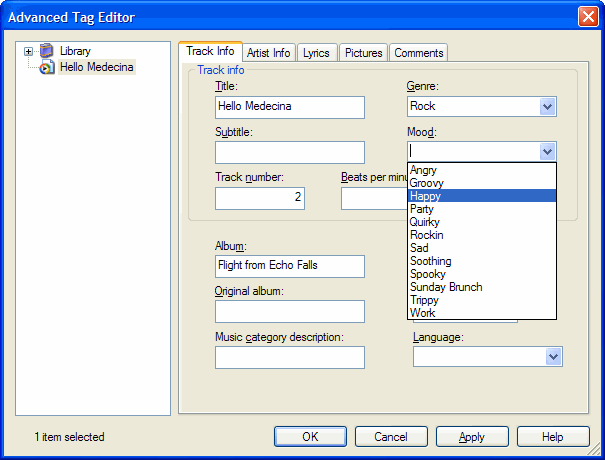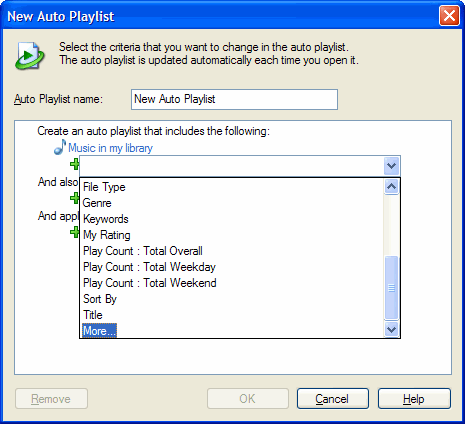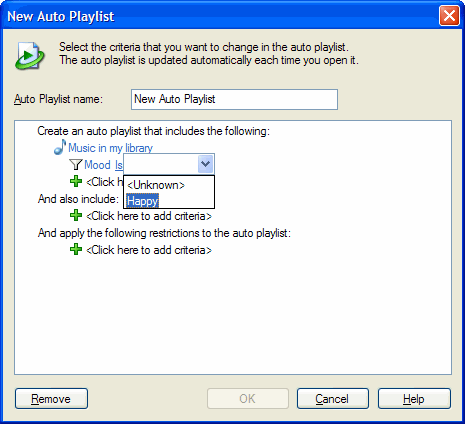Emotional Playlists
One of the things I find poorly implemented in Windows Media Player and completely missing from iTunes is something I refer to as emotional playlists. All the major music players have rating systems based on the concept of one to five stars. Music is either one start, which presumably means it sucks; two stars for not quite so bad; three stars for middle of the road; four stars for better than average; or five stars for killer track (or something). Who honestly thinks about songs on a scale of one to five? Rating your music based on emotion makes more sense.
Take two tracks I really like. Hello Medecina by The Vells and Brother's Gonna Work It Out from the DJ Spooky vs. Dave Lombardo collaboration. On a five-star scale both tracks are a five. That doesn't mean I want to hear the two tracks in the same mix. The Vells album is an upbeat throwback to late Sixties pop music. DJ Spooky vs. Dave Lombardo is an aggressive collection of tracks heavy on drum samples and fast beats. These are certainly not two tracks that are emotionally compatible.
In an ideal universe, the Auto Playlist feature of Windows Media Player (or Smart Playlist in iTunes) would include a configurable list of playlists for things like Angry, Sad, Happy, Angst Filled Afternoon or whatever. The list of emotions might have a few base emotions, but would also include an Add Your Own feature so I can define emotional music lists based on the way I think about my music collection. Adding a file to one of these lists would automatically tag the song file as being a 'Happy' song or a 'Sad' song.
Windows Media Player 10 includes an overwhelming tag editor called Advanced Tag Editor, which was available as a standalone download for Player 9. It's got some annoying quirks, like over-riding user defined Genre choices if you re-sync with the online music database for updated details like Album Art and Artist Info. In general, the editing features work well, allowing you to browse your entire library and make changes. One feature included in the Track Info tags is a Mood setting, which hints at my emotional playlist concept. Mood includes twelve selections including: Angry, Groovy, Happy, Party, Quirky, Rockin, Sad, Soothing, Spooky, Sunday Brunch, Trippy and Work. While I wouldn't use most of those terms to describe anything, it's a basic framework for what could be a killer feature.

Taking the Mood tag a step further, I flip to the Windows Media Player Library tab, right click Auto Playlists and choose New (another feature that should be easier to use).

The New Auto Playlist wizard pops up. Click to add criteria and choose More to expose the complete list of options.

Scrolling through the filter list, I find the Mood option, which adds it as Mood Is (which could also be Is Not). Assuming you have defined at least one mood, the click to set drop down list will include any available moods. Since I set Hello Medecina as a Happy song, I'll choose 'Happy' from the list. After changing the name of my play list to 'Happy Songs', I close the New Auto Playlist wizard by clicking OK.

As long as I tag a whole bunch of songs as 'Happy' this list will continue to grow. A better system would be to create the playlist and allow me to grow the list by dragging and dropping tracks to make them part of the Happy Songs playlist, auto-tagging them with the Mood 'Happy' as they add to the list. Keeping that five-star system relevant, an additional iteration of my 'Happy Songs' list a playlist that only plays 'Happy' mood songs with a 4 or 5 star rating, so I get my favorite Happy Songs.
The next stage is to pass this mood data to my portable music player so that I can change my mood music throughout the course of a day.